We’ve had rabbits around the homestead for over 4 years now. For the most part, raising rabbits been something that I have really enjoyed. Bunnies are adorable and soft. Their poop is excellent fertilizer. Cutting greens for them twice daily keeps me disciplined to weed the paths and garden beds. Occasionally, our family is nourished by their meat too. Though admittedly we don’t butcher our rabbits often. I tend to get attached to too many of the babies and end up selling/bartering them to friends instead.
The hardest part of raising rabbits is that as prey animals, they are delicate by design. It’s nature’s way of keeping their populations in check, I think. Rabbits only gestate for a month and can get pregnant pretty much immediately after giving birth. They could technically have a litter a month, and with 5-7 babies per litter, that’s A LOT of rabbits very quickly. So it makes sense that they can be fairly susceptible to disease and predation.
Proper care, however, can go a long way to helping rabbits thrive. In this post, I’ll be laying out the basics of caring for rabbits.
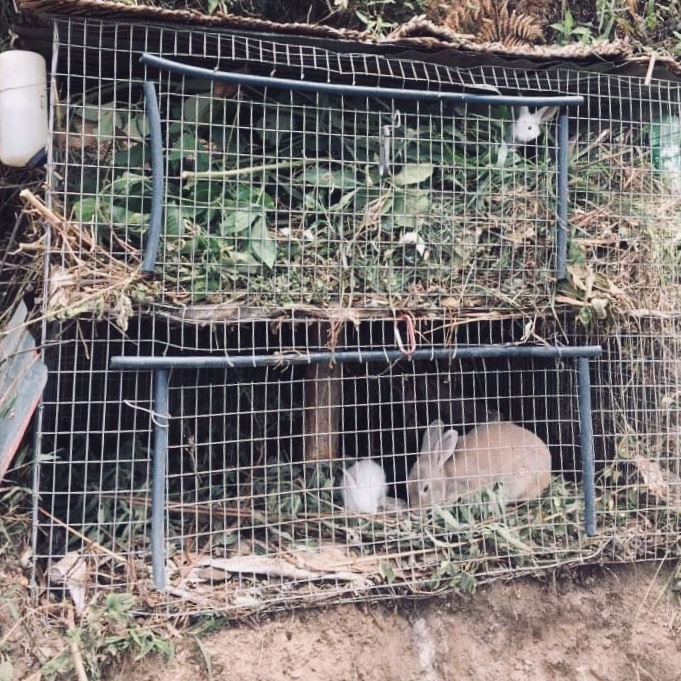
Housing
Secure housing is one of the most important things you will need to keep your rabbit safe.
Rabbits are extremely vulnerable to attacks from predators of all kinds — dogs, cats, a variety of wild animals, and even birds of prey. Determined predators can break caging material or get in through cage doors. Most incidents occur at night, so if you can’t be sure that your rabbit’s cage is secure, you may want to bring them indoors for the evening.
Mature rabbits have the instinct to burrow, and will do so if given the opportunity. In our early rabbit keeping years, we had several rabbits burrow out of their cages. Many were caught before harm came to them, but a few of the unfortunate ones were killed by dogs while roaming free. Now, we line our cage floors with sturdy wire. We then layer grass and other plants on top as padding, so they don’t have to stand on the hard metal.
Because our rabbits aren’t able to burrow, we like to provide them with a bucket (we use broken buckets, as they are plentiful around the homestead) turned on it’s side or a box. This becomes their safe space. As prey animals, rabbits will instinctively seek a place to hide if something startles them or if they feel threatened.
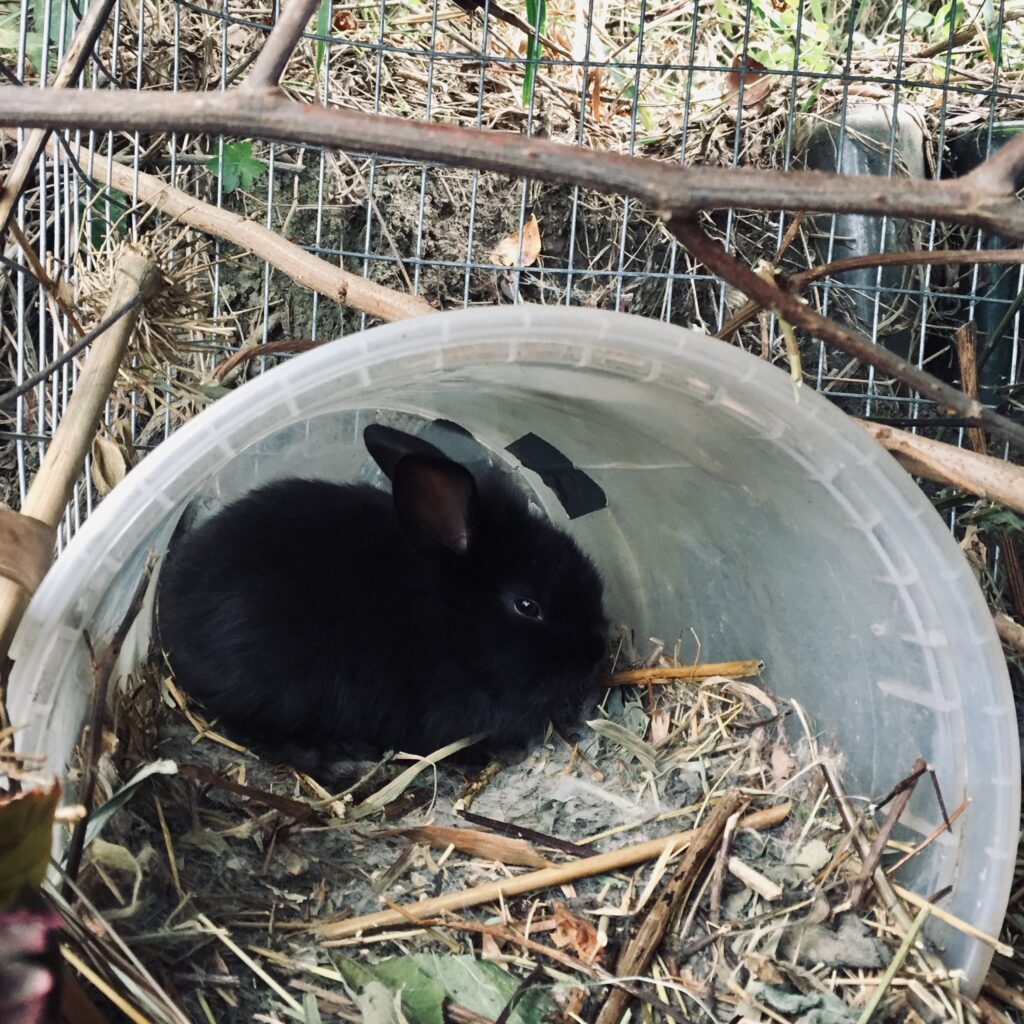
Rabbits will also need protection from the elements, if their cages are outdoors. They will need some sort of roof to keep them dry, and a spot to get shade so they aren’t overheated by excess sun exposure. Folks in colder climates will want to keep their bunnies indoors when temperatures drop.
Indoor rabbits who are allowed to roam free in the home should be kept away from electric cords, which are tempting for them to chew on. A rabbit can quickly gnaw through electric cords. The home should also be “bunny proofed” to ensure there aren’t other possible hazards. The House Rabbit Society gives tips on their page “Rabbit Proofing.”
Food
It is extremely important that your rabbit has access to fresh, clean water at all times. The amount of water your rabbit drinks will vary depending on many factors, including what they are eating, outdoor temperature, whether they are lactating, and so on. Check your rabbit’s water supply regularly and be sure they always have plenty. We use water bottles that hang on the side of the cage, as bowls of water are easily tipped over by hopping rabbits.
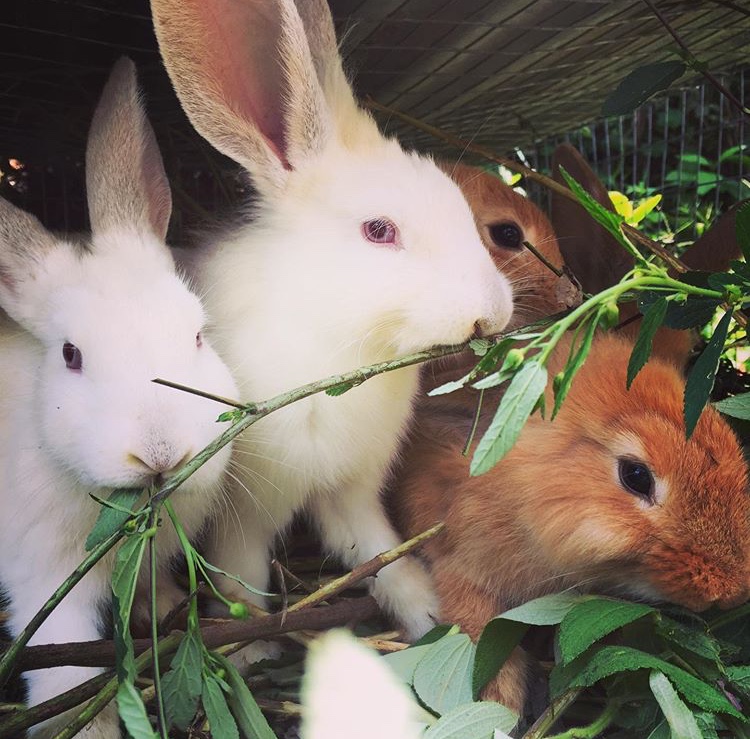
The majority of a rabbit’s diet should be a variety of fresh greens. Fresh foods are important as they provide many nutrients, as well as different textures and flavors for your bunny to enjoy. Greens also contain water, which helps to promote healthy kidney & bladder function.
Greens should always be harvested from a place that is not sprayed with pesticides or too close to a road, as the pollution from cars can contaminate plants growing nearby. Our rabbits eat many of the native grasses and shrubs that grow here. We give them a large bundle of these fresh “weeds” twice daily. Rabbits also appreciate the fresh leaves of common herbs, such as plantain, yellow dock, mint, dandelion, basil, cilantro, fennel, dill, borage, and comfrey.
Many plants naturally contain alkaloids, which are mildly toxic. Oxalic acid is one such chemical. It is completely harmless when consumed in small amounts, but toxicity — leading to kidney damage —can occur if fed in large quantities. The amount of oxalic acid a plant contains will vary significantly due to several factors like the composition of the soil the plant grew in, the time of year the plant was harvested, and the age of the plant.
Most of the fresh greens and vegetables we feed to rabbits are low in oxalates, but a few, have relatively high levels. These foods are quite nutritious and do not need to be completely eliminated from the diet. Instead they simply need to be fed appropriately — in small amounts and not at every feeding. Leafy greens that should be limited due to oxalate content include:
- Parsley
- Spinach
- Mustard greens
- Beet greens
- Swiss chard
- Radish tops
- Sprouts (from 1 to 6 days after sprouting, sprouts have higher levels of alkaloids)
In general it is best to feed a minimum of 3 types of leafy greens a day (only one of them containing high levels of oxalic acid). Don’t feed the same greens all the time — mix it up if possible. Feeding your bunny a variety of greens ensures they are getting many different nutrients and makes them much less likely to have any issues with toxicity.
In addition to leafy greens, you can also feed small amounts of fresh vegetables (these should make up no more than about 15% of your rabbit’s diet), such as:
- Carrots
- Broccoli (leaves & stems)
- Edible flowers (roses, nasturtiums, pansies, hibiscus)
- Celery
- Bell peppers (any color)
- Chinese pea pods (the flat kind without large peas)
- Brussel sprouts
- Cabbage (any type)
- Broccolini
- Summer squash
- Zucchini squash
Avoid foods in the onion family, like leeks, onions, and chives, as they can be harmful to your rabbit.
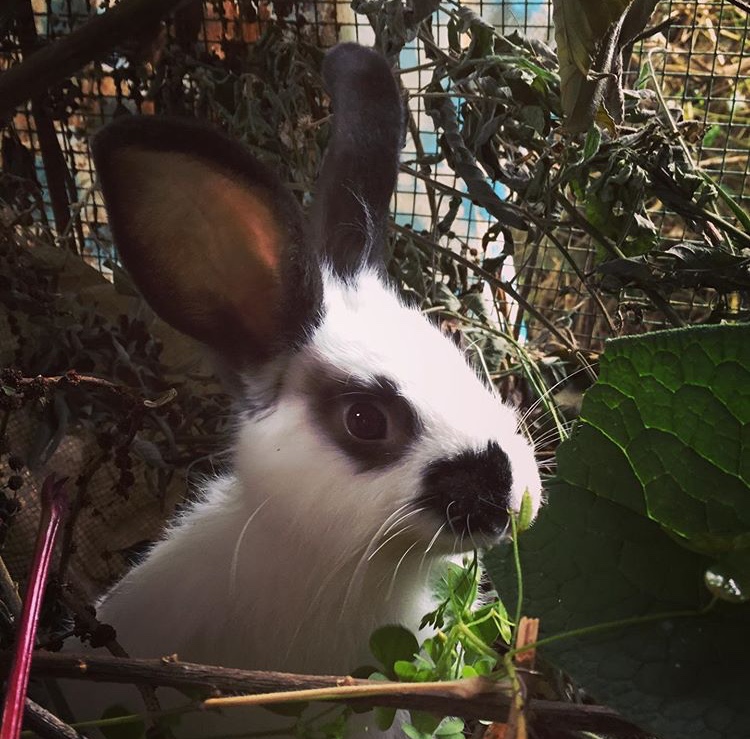
Unprocessed oats are be a great addition to your rabbit’s diet. We regularly give a small amount of oats to all of our rabbits. Pregnant or lactating bunnies and those who are suffering from parasite issues will receive increased rations. Oats contain fats, proteins, minerals and vitamins to support overall health, particularly strong nails, teeth, and hair. They can help support the immune system, and give rabbits an extra boost to heal from health issues.
We also regularly supplement with a mineral salt mix that is blended specifically for rabbits. This ensures there are no gaps in the essential nutrients our rabbits need to maintain optimal health. We simply mix these salts in with the oats, and our rabbits eat the blend happily.
For a comprehensive list of foods that are/are not safe for rabbits check out this page from Rabbit Expert.
Grooming
Like cats, rabbits regularly groom themselves and will lick themselves clean. Short haired rabbits don’t need much assistance maintaining their coats, however, long furred rabbits need to be brushed regularly (at least once a week or so) to keep from fur from getting matted and dreadlocked. If knots form, you may need to snip them out, taking great care not to cut the rabbit’s delicate skin.
A rabbit’s nails may grow to the point where they are so long and sharp that they are uncomfortable. To prevent his from happening, you can give them a trim. Look at the nail, see where the blood is inside, and cut short of that point. Keep cayenne or yarrow powder or another hemostatic on hand to stop the bleeding if you accidentally cut the nail too short.
Handling
Rabbits don’t always react well to being picked up. They may run, hide, kick, scratch, and wriggle to try to escape your grasp. Bunnies should not be lifted by the ears or scruff. The House Rabbit Society’s page, “An Uplifting Experience” details the best methods for handling rabbits safely.
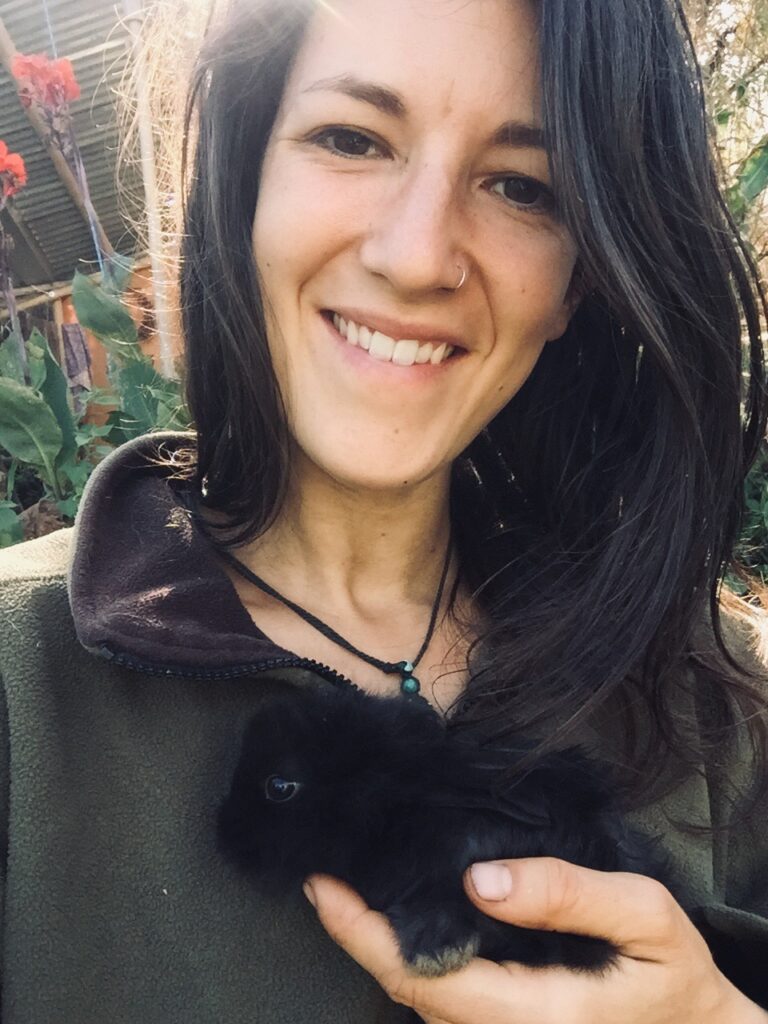
So there you have it. That’s the basic information you need to know to start raising rabbits.
For more information on keeping rabbits healthy, check out my post: Treating Mite (Sarcoptes scabiei) Infestations in Rabbits


Hi, on our computer, the text on this blog post is not legible at all. Cute pics tho! I left the mugwort with Marino.
He seems tuned into it to give it water every day. Try to pick it up soon!
Z
Oh! after commenting the page changed completely. Now it is totally legible, bright, easy to read. Funny feature.
Pingback: Treating Mite (Sarcoptes scabiei) Infestations in Rabbits - Sierra y Cielo
Pingback: Myxomatosis in Rabbits - Sierra y Cielo